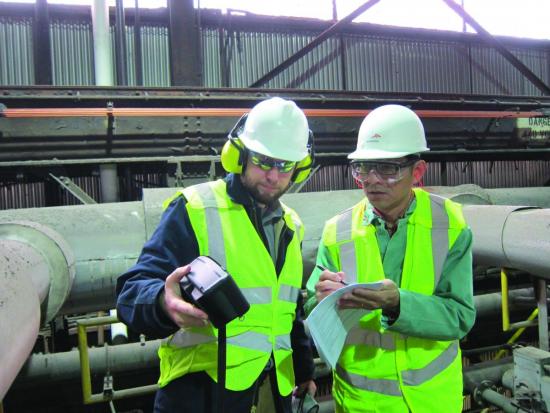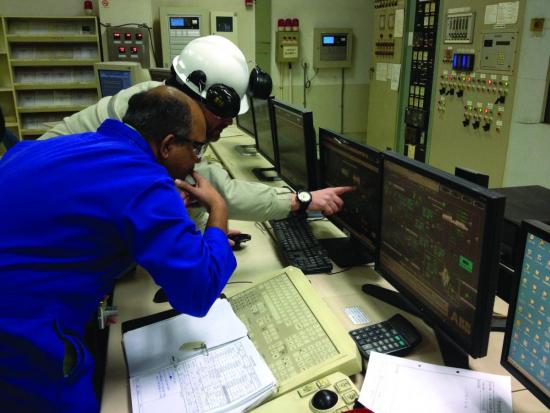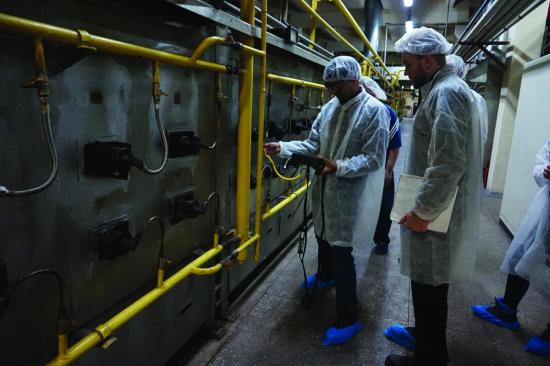Manufacturers have always known it’s not always easy to make improvements in energy and water efficiencies. Fortunately, more and more companies are learning there’s plenty of help available through the Department of Energy (DOE) Better Plants® program that makes the job a whole lot easier.
In 2019, more than 230 Better Plants partners took advantage of the program to gain considerable ground in their sustainability efforts. In so doing, they cumulatively saved more than \$6.7 billion in energy costs and more than 1.3 quadrillion British Thermal Units (BTUs). These same companies have more than 3,200 facilities and represent approximately 12% of the U.S. manufacturing energy footprint. In addition to energy, partners are excelling at projects to improve water efficiency.
Last year also saw 22 companies joining the rapidly growing list looking to capitalize on the advantages of the program, pointing to good days for those who place a priority on environmental sustainability, said Thomas Wenning, a registered Professional Engineer and Program Manager for Industrial Energy Efficiency at the DOE’s Oak Ridge National Laboratory (ORNL).
“I’m really excited about how far we’ve come since the program started. We’re in a really good place in terms of partners showing success and the number of companies pledging to additional long-term goals,” said Wenning who provides Better Plants partners with technical assistance and energy management guidance. Wenning also serves as Assistant Professor in the Department of Industrial and Systems Engineering at the University of Tennessee.

A growing number of manufacturers are taking advantage of the Department of Energy (DOE) Better Plants® program and saving on energy and water in the process.
Committing to Environmental Stewardship
Through the Better Plants program (https://betterbuildingssolutioncenter.energy.gov/better-plants), which officially launched in 2011, the DOE works with closely with partners to achieve energy and water efficiency improvement goals – while offering a host of resources.
Manufacturers don’t need to meet any qualifications to become a Better Plants partner and gain access to the numerous perks that go with it. Instead, they’re asked to voluntarily set a specific goal, typically to reduce energy intensity by 25% over a 10-year period across all of their U.S. operations. The program also includes the Better Plants Challenge, in which partners commit to a higher-level of transparency than the Better Plants program.
The underlying goal of the program is to give manufacturers another leg up if they need it, said Wenning.
“The business-as-usual approach is to let people do it themselves and that’s perfectly fine. Some companies are good at it; others not so much,” Wenning said. “Really, the whole reason for this program is to provide a leadership platform that allows leading companies to showcase what they’re doing – and then using that as a motivator for all companies to hopefully step up their game.”
In addition to serving as a source of motivation, the DOE recognizes that many companies don’t have the resources to devote to sustainability, Wenning said.
“A lot of it has to do with filling that void within a company,” he said. “A lot of companies are extremely busy, and while they might have an energy manager at the facility, he’s not just the energy manager, he’s also the engineering guy, the maintenance guy and he’s wearing a lot of different hats.”
Making it easier for manufacturers to save energy and water wherever they can not only helps the environment; it also helps companies become more competitive.
“Whether it’s a dollar saved on electricity, or a dollar saved on water, that goes directly to the bottom line,” Wenning said. “That in turn, has a multiplier effect that allows a company to invest in people, or technologies, or capital equipment. Or, it can just be pure profit, which in an ideal world, is going to grow the business.”
Learning from the Best and Brightest
Many Better Plants partners are proven leaders in environmental sustainability, which is integral to the program since successful partners share their experiences and insights. That gives others ample opportunity to learn from the best.
“While the program is a leadership platform to showcase great achievements, we work with a lot of companies who aren’t leaders – yet. The program offers a great opportunity for companies just starting on their energy- or water-efficiency journey because they can learn from this collective experience that’s been developed over the years.”

Information-sharing is a vital component of the Better Plants program.
Whether a company is a Better Plants rock star, or just getting started, all companies gain access to a wealth of knowledge as well as a deep reservoir of resources.
Among the resources is a dedicated technical account manager who helps partners establish energy baselines, develop energy and management plans, identify energy-saving and energy-recovery opportunities, and track performance metrics. An account manager is also assigned to each partner.
“Our technical account managers are engineers with a lot of experience, and in some cases, we have people with 30-plus years of experience and/or doctorate degrees,” Wenning said. “Our account managers are there to figure out where companies are at in their energy or water journey and how we can help.”

As part of the Better Plants program, experienced engineers guide companies toward energy and water efficiencies.
Among the many resources available to members are In-Plant Trainings. The two- to four-day clinics are led by technical account managers and focused on a variety of areas, such as system optimization and energy management.
An example of In-Plant Training focused on achieving efficiencies is compressed air systems. Topics range from eliminating inappropriate uses of compressed air to the delivery of appropriate compressed air pressure and ensuring compressed air quality. In some cases, the In-Plant Training might be designed to help manufacturers understand the true costs of water and identify opportunities for water efficiencies.
“In-Plant Trainings have been one of our most popular offerings,” Wenning said. “We’re able to send in an expert for a couple of days where they can not only find some really solid opportunities and projects at their site, but then also train people within the company so they can replicate what they’ve learned.”
Energy Assessment Tools at Your Disposal
In addition to dedicated resources and training services, Better Plants partners are provided access to an assortment of tools at no charge to improve their energy data collection, analysis and validation efforts.
The Diagnostic Equipment Program lets partners borrow equipment free of charge for up to four weeks so they can test individual instruments before investing in them. The long list of tools available include invaluable instruments, such as pressure transducers, power loggers and ultrasonic leak detectors.

Better Plants partners get to the chance to put diagnostic equipment to the test before investing in it.
“What’s really great is that we can come in and offer advice and technologies from an agnostic standpoint. We’re not trying to sell anything; we’re just trying to put good information out there and highlight best practices,” Wenning said.
Among the highly useful tools is the Energy Treasure Hunt Exchange Toolkit, which aids in the process of planning and performing Energy Treasure Hunts. The toolkit provides the treasure hunt participants with tools to effectively plan for the event, successfully run it and track results. To learn more about Energy Treasure Hunts, visit www.airbestpractices.com/energy-manager/corporate-sustainability-programs/culture-building-energy-star%C2%AE-energy-treasure-hunts.
Also available to Better Plants partners – and non-partners alike – is DOE’s Manufacturing Energy Assessment Software for Utility Reduction (MEASUR) software tool suite. MEASUR consists of updated DOE legacy energy system assessment tools designed to help manufacturers increase industrial energy efficiency, both at the plant and system level.
The tool suite, which does away with several older legacy and siloed tools written in a variety of programming languages, was created to provide a more user-friendly and versatile set of tools. MEASUR also ensures interoperability between the individual tools and gives users the ability to assess most major support systems, including pumping, fans, process heating, steam, motors, and compressed air. By entering facility-specific energy and operating data, users can discover how much energy each piece of equipment uses annually, plus estimated annual energy cost so they can evaluate opportunities for improvement.
“We’re incredibly excited about MEASUR,” said Wenning. “The feedback we’re getting about it is overwhelmingly positive from industrial end-users, as well as consultants and public utilities. We’ve brought all of these different tools into one platform and it’s super flexible. It’s also open to everyone.”
Whether it’s software tools, instruments for data collection and accurate system assessments, or the wide range of other Better Plants program resources, the goal is to help manufacturers overcome barriers to improving energy and water efficiencies.
“There’s the information barrier,” Wenning said, pointing to an example of a common challenge in the industry. “Knowing what you could be doing differently and what resources or best practices you should implementing is challenging when you’re working in a facility and trying to get product out the door. Beyond that, energy managers face a cultural barrier of convincing colleagues that energy is important. And obviously, one of the most common and challenging barriers is trying to make the case for financing capital investments to improve energy efficiency.”
Another resource gaining in popularity is the annual Better Plants Technology Day event, which gives partners the opportunity to visit one of the seventeen DOE National Laboratories to learn firsthand about various early-stage technologies best positioned to enable industrial competitiveness and innovation.
“The DOE has invested heavily in R&D and we want to help companies make connections that will guide them along in the world of the next technologies that address industry problems and challenges,” Wenning said.
More Partners, More Pledges, More Environmental Sustainability
While the Better Plants program offers many resources and tools to choose from, Wenning said the program is built around the needs of manufacturers looking to improve energy and water efficiencies.
“We’re always looking to see where the industry is raising its hand and providing the resources needed,” Wenning said, noting how the Better Plants program is also gaining more and more attention and increasingly better results.
“There are many companies that have already met their 10-year goals, and in numerous cases, they did it ahead of time. Many of those same companies have repledged to aggressive goals beyond that,” Wenning said. “That, in and of itself, shows the value of the program. Our partners are fantastic companies who are not resting on their laurels. They’re continuing to push forward.”
To read similar sustainability articles, please visit www.airbestpractices.com/sustainability-projects.




